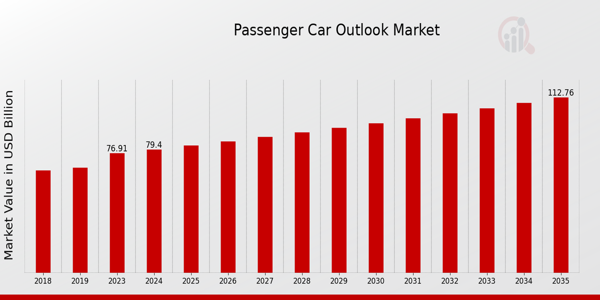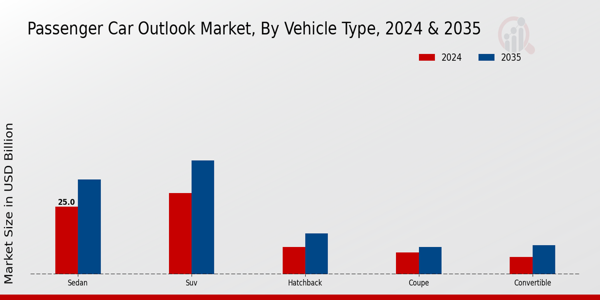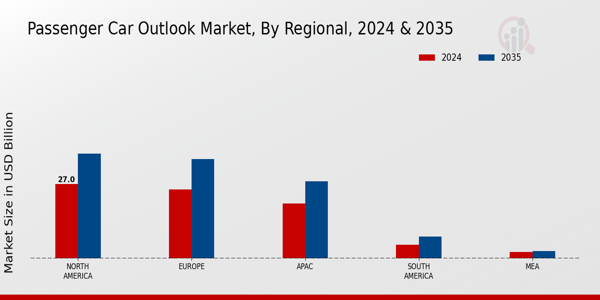Global Passenger Cars Market Overview
As per MRFR analysis, the Passenger Cars Market Size was estimated at 76.91 (USD Billion) in 2023.The Passenger Cars Market is expected to grow from 79.4 (USD Billion) in 2024 to 112.7 (USD Billion) by 2035. The Passenger Cars Market CAGR (growth rate) is expected to be around 3.24% during the forecast period (2025 - 2035).
Key Passenger Cars Market Trends Highlighted
Regulatory pressures, technology improvements, and shifting consumer tastes are driving a number of noteworthy market trends in the Passenger Cars Market. The rising demand for electric vehicles as consumers get more environmentally concerned and governments impose stricter emissions laws is one of the major factors driving the market.
This change is also being fueled by improvements in battery technology and increased investment in the infrastructure for electric vehicles. Adoption of alternative fuel vehicles is also being aided by growing urbanization and an emphasis on environmentally friendly transportation options. The market offers opportunities for the incorporation of smart technologies into passenger cars.
Features like advanced driver assistance systems (ADAS), connectivity options, and autonomous driving capabilities are gaining traction. Companies that innovate in these areas stand to capture a growing segment of tech-savvy consumers who prioritize safety and convenience in their purchasing decisions.
Furthermore, collaborations between traditional automotive manufacturers and tech companies provide avenues for enhanced research and development, creating even more opportunities for growth. Recent trends include the shift towards subscription models and shared mobility solutions, as consumers favor flexible ownership options over traditional car ownership.
This has led to an increase in car-sharing services and a focus on fleet management solutions. The rise of digital platforms for vehicle purchase and maintenance services is also changing how consumers engage with the market.
These shifts indicate a significant transformation in consumer behavior and present opportunities for businesses to adapt to evolving market dynamics effectively. The emphasis on sustainability, technology integration, and evolving consumer needs will continue to shape the Passenger Cars Market going forward.

Source: Primary Research, Secondary Research, MRFR Database and Analyst Review
Passenger Cars Market Drivers
Increasing Urbanization and Global Population Growth
The rise in urbanization and global population is one of the most significant drivers influencing the Passenger Cars Market. As more people move to urban centers, the demand for passenger vehicles grows substantially.
This demographic shift leads to increased mobility needs, as urban dwellers require efficient and reliable transportation options. Moreover, an expanding middle class in various regions, especially in emerging markets, enhances purchasing power, enabling a broader segment of the population to invest in personal vehicles.
The need for convenient transport solutions in bustling cities cannot be underestimated, as public transport systems often struggle to accommodate the increasing population density. Furthermore, as urban environments evolve, there is a shift towards sustainable and eco-friendly vehicle options.
This multifaceted demand, driven by urbanization and population dynamics, creates a robust market opportunity for new models and technologies, ultimately shaping the future landscape of the Passenger Cars Market.
In this context, manufacturers are also adapting their strategies to cater to the preferences of urban consumers who are inclined towards fuel-efficient and compact vehicles. Therefore, the interplay between population growth, urbanization, and consumer preferences is a crucial element that directly impacts the market size and growth trajectory.
Technological Advancements in the Automotive Industry
Continued technological advancements in the automotive sector are another powerful driver of growth in the Passenger Cars Market. Innovations such as electric vehicles (EVs), autonomous driving technology, and smart connectivity features revolutionize personal car experiences.
As consumers become more conscious of environmental impacts, the shift towards electric and hybrid cars is accelerating. Furthermore, advancements in safety features, infotainment systems, and driver-assistance technologies are making personal vehicles not only more appealing but also safer and more user-friendly.
The integration of technology also supports enhanced vehicle performance and efficiency, meeting the growing consumer demand for modern and environmentally sustainable transportation solutions.
Government Initiatives and Regulations
Government initiatives promoting sustainability and reducing carbon emissions are increasingly shaping the Passenger Cars Market. Legislative frameworks designed to enhance energy efficiency and environmental safety drive manufacturers to innovate and adapt.
Policies encouraging the use of electric vehicles through incentives, subsidies, and investments in charging infrastructure create favorable conditions for market expansion. With more stringent emission regulations emerging in many regions, automakers are motivated to develop greener vehicles, directly influencing consumer choice and preferences in the passenger car market.
Passenger Cars Market Segment Insights
Passenger Cars Market Vehicle Type Insights
The Vehicle Type segment in the Passenger Cars Market exhibited significant diversity, reflecting evolving consumer preferences and market trends.
In 2024, the Sedan category held a valuation of 25.0 USD Billion, showcasing its continued relevance among consumers seeking practicality and comfort. Despite the rise of SUVs, Sedans remained a staple choice, often associated with favorable fuel efficiency and lower cost of ownership.
Moving to SUVs, which dominated the market with a projected valuation of 30.0 USD Billion in 2024, they represented a significant shift in consumer preference towards larger vehicles that offered enhanced space and versatility. This segment captured the majority holding in the market as buyers increasingly favor the elevated driving position and safety features associated with SUVs.
The Hatchback segment generated 10.0 USD Billion in 2024, appealing to urban consumers who prioritize compactness and ease of maneuverability in congested environments. Although Hatchbacks catered to a more niche audience, their practicality and affordability secured a dedicated consumer base, contributing positively to the overall market dynamics.
The Coupe market, valued at 8.0 USD Billion in 2024, had a unique appeal, offering a sportier aesthetic and driving experience, thereby attracting enthusiasts looking for a more dynamic vehicle. Though smaller in size compared to Sedans and SUVs, the Coupe segment commanded attention for its design and performance features.
Lastly, the Convertible segment, valued at 6.4 USD Billion in 2024, captured the interest of those seeking open-air driving experiences. While it represented a smaller fraction of the overall market, it symbolized luxury and lifestyle aspirations, attracting customers in regions with favorable climates.
Overall, the Passenger Cars Market segmentation reflected a blend of utility, style, and consumer preference, with each vehicle type fulfilling specific needs in the automotive landscape.

Source: Primary Research, Secondary Research, MRFR Database and Analyst Review
Passenger Cars Market Fuel Type Insights
The segment encompasses various fuel types, including Gasoline, Diesel, Electric, Hybrid, and Plug-in Hybrid, each playing a distinct role in the market landscape. Gasoline and Diesel vehicles have historically dominated the market due to their wide availability and established infrastructure.
However, the shift towards Electric and Hybrid vehicles is gaining traction, driven by increasing consumer awareness regarding environmental sustainability and government incentives promoting lower emissions.
The Electric vehicle category is particularly significant as it represents a growing trend towards cleaner transportation solutions, while Plug-in Hybrid vehicles provide a transitional option for consumers. As the automotive industry adapts to changing environmental regulations and consumer preferences, the Fuel Type segment is poised for continual evolution.
Overall, trends within the Passenger Cars Market indicate significant opportunities for innovation, derived from rising demand for alternative fuels and sustainable vehicle technologies, thereby shaping the future of the market.
Passenger Cars Market Engine Capacity Insights
The market encapsulates diverse engine capacities, catering to varied consumer preferences and regulatory standards.
The classification includes engines with capacities of Less than 1.5L, 1.5L to 2.0L, 2.0L to 2.5L, and Above 2.5L. The segment of engines with capacities less than 1.5L is increasingly favored due to their fuel efficiency and compliance with strict emissions regulations, becoming a major holding in the market.
Meanwhile, the 1.5L to 2.0L category balances performance and efficiency, making it a popular choice among consumers seeking an optimal driving experience. Vehicles in the range of 2.0L to 2.5L cater to a niche segment that values higher performance while still being compliant with environmental standards.
Conversely, the Above 2.5L category attracts enthusiasts prioritizing power, offering advanced technology for enhanced performance, thereby providing a significant contribution to the overall market dynamics. As the market continues to evolve, trends such as electric vehicle integration and emission reduction regulations present both opportunities and challenges across these diverse capacities.
The Passenger Cars Market data reflects a dynamic interplay of consumer demands and industry advancements, driving the need for continuous innovation within all engine capacity segments.
Passenger Cars Market Transmission Type Insights
The Transmission Type segment of the Passenger Cars Market demonstrates a notable shift in consumer preferences and technological advancements.
Key drivers include the increasing demand for high-efficiency vehicles, with Automatic transmissions gaining traction due to their user-friendly nature and improved fuel efficiency. The Manual transmission type continues to maintain a significant presence among driving enthusiasts, as it offers a more engaging driving experience.
Meanwhile, Continuously Variable Transmissions (CVT) are becoming increasingly popular owing to their smooth performance and efficiency in various driving conditions. The Semi-Automatic option appeals to consumers looking for a blend of control and convenience, catering to a growing market segment focused on enhanced driving pleasure.
The segmentation within the Passenger Cars Market illustrates diverse consumer preferences and highlights the crucial role each transmission type plays in shaping the overall driving experience and technology advancement in the industry.
As the market continues to evolve, understanding this segmentation is key to capturing growth opportunities within the Passenger Cars Market statistics.
Passenger Cars Market Regional Insights
The Passenger Cars Market was poised for growth across various regions, with North America and Europe currently leading in market value. In 2024, North America was valued at 27.0 USD Billion, reflecting its dominant position in the industry due to its robust automotive manufacturing sector and consumer demand for passenger vehicles.
Europe closely followed, valued at 25.0 USD Billion, driven by innovation and a strong focus on sustainability in transportation. APAC, valued at 20.0 USD Billion in 2024, showed significant potential due to rapid urbanization and increasing disposable income.
South America, with a valuation of 5.0 USD Billion, faced challenges but presented opportunities through the growing middle class and a shift towards vehicle ownership. Meanwhile, the MEA region, though valued at 2.4 USD Billion, gradually expanded as infrastructure improved and economic conditions became favorable for new car sales.
The market growth was influenced by evolving consumer preferences, technological advancements, and stricter emissions regulations, underscoring the importance of regional dynamics within the Passenger Cars Market revenue landscape.

Source: Primary Research, Secondary Research, MRFR Database and Analyst Review
Passenger Cars Market Key Players and Competitive Insights
The Passenger Cars Market is a dynamic and rapidly evolving sector characterized by intense competition, technological advancements, and shifting consumer preferences. This market is influenced by various factors, including economic shifts, regulatory environments, and advancements in automotive technology.
Competitive insights into this market reveal the strategies employed by major industry players to enhance their market share, improve customer experience, and innovate their product offerings. Major organizations are focusing on electric and hybrid vehicles, integrating smart technologies, and enhancing sustainability efforts.
The landscape is increasingly marked by collaborations and partnerships aimed at leveraging shared resources and expertise to gain competitive advantage while navigating the complexities of global supply chains and changing market demands.
Daimler AG stands out within the Passenger Cars Market with its strong brand reputation and commitment to innovation. The company has successfully established a robust portfolio of vehicles, including luxury sedans and high-performance models under its flagship brands, which cater to a diverse spectrum of consumers.
Daimler AG's investment in electric vehicle technology showcases its foresight in meeting future mobility trends, positioning the company favorably amid increasing demand for environmentally friendly alternatives.
Additionally, the company's integration of advanced connectivity features enhances user experiences and aligns with the industry's shift toward digitalization. With a strong global presence, extensive distribution networks, and a focus on sustainability, Daimler AG is well positioned to maintain its competitive edge in the evolving landscape of the passenger car market.
General Motors has made significant strides in the Passenger Cars Market by adopting a proactive approach towards electric vehicles and advanced automotive technologies. The company has invested heavily in research and development to launch a range of electric and autonomous vehicles, thus addressing the shifting consumer preferences towards greener and more innovative transportation options.
General Motors is recognized for its strong brand loyalty and extensive customer base, enabling it to effectively penetrate various regional markets. The company leverages its vast manufacturing capabilities and global supply chain to ensure efficient production and distribution of vehicles.
Furthermore, General Motors is focused on enhancing its sustainability practices, aligning with global trends towards reducing carbon footprints, which posit the company favorably in the eyes of both investors and consumers.
Through strategic partnerships and initiatives focused on electrification and technological evolution, General Motors remains a formidable competitor in the global passenger car market.
Key Companies in the Passenger Cars Market Include
- Daimler AG
- General Motors
- Subaru
- Volkswagen
- Hyundai Motor
- Mazda
- Tesla
- Audi
- BMW
- Stellantis
- Nissan Motor
- Toyota Motor
- Kia
- Ford Motor
- Honda Motor
Passenger Cars Market Developments
Recent developments in the Passenger Cars Market have shown a significant shift towards electric vehicle (EV) production, with companies like Tesla and Volkswagen ramping up their EV offerings. Daimler AG and BMW are also investing heavily in battery technology to support their electric models.
Meanwhile, General Motors is expanding its manufacturing footprint in North America to bolster EV production, aiming to increase market share in the competitive landscape. In the realm of mergers and acquisitions, Hyundai Motor has acquired a stake in robotaxi company Motional to enhance its mobility services, signaling a strategic move towards integrated vehicle solutions.
Toyota Motor continues its focus on hybrid technology, positioning itself as a leader as the market evolves. Forward-looking market valuations indicate a positive trend for companies like Kia and Ford Motor, reflecting confidence in sustained growth driven by consumer demand for innovative features and sustainability.
Subaru has also announced plans to increase production capabilities for its hybrid models, aligning with market trends. The ongoing shifts in regulations, technology, and consumer preferences continue to shape the landscape of the global passenger car market.
Passenger Cars Market Segmentation Insights
Passenger Cars Market Vehicle Type Outlook
- Sedan
- SUV
- Hatchback
- Coupe
- Convertible
Passenger Cars Market Fuel Type Outlook
- Gasoline
- Diesel
- Electric
- Hybrid
- Plug-in Hybrid
Passenger Cars Market Engine Capacity Outlook
- Less than 1.5L
- 5L to 2.0L
- 0L to 2.5L
- Above 2.5L
Passenger Cars Market Transmission Type Outlook
- Manual
- Automatic
- CVT
- Semi-Automatic
Passenger Cars Market Regional Outlook
- North America
- Europe
- South America
- Asia Pacific
- Middle East and Africa
| Report Attribute/Metric |
Details |
| Market Size 2023 |
76.91(USD Billion) |
| Market Size 2024 |
79.4(USD Billion) |
| Market Size 2035 |
112.7(USD Billion) |
| Compound Annual Growth Rate (CAGR) |
3.24% (2025 - 2035) |
| Report Coverage |
Revenue Forecast, Competitive Landscape, Growth Factors, and Trends |
| Base Year |
2024 |
| Market Forecast Period |
2025 - 2035 |
| Historical Data |
2019 - 2024 |
| Market Forecast Units |
USD Billion |
| Key Companies Profiled |
Daimler AG, General Motors, Subaru, Volkswagen, Hyundai Motor, Mazda, Tesla, Audi, BMW, Stellantis, Nissan Motor, Toyota Motor, Kia, Ford Motor, Honda Motor |
| Segments Covered |
Vehicle Type, Fuel Type, Engine Capacity, Transmission Type, Regional |
| Key Market Opportunities |
Electric vehicle adoption surge, Autonomous driving technology development, Enhanced connectivity features demand, Sustainability and eco-friendly materials, Growing shared mobility services |
| Key Market Dynamics |
Market demand fluctuations, Technological advancements, Regulatory compliance, Economic growth impacts, Consumer preference evolution |
| Countries Covered |
North America, Europe, APAC, South America, MEA |
Frequently Asked Questions (FAQ) :
The Passenger Car Outlook Market was valued at 79.4 USD Billion in 2024.
The market is projected to reach 112.7 USD Billion by 2035.
The expected CAGR for the market during this period is 3.24%.
North America held the largest market value at 27.0 USD Billion in 2024.
The SUV segment is expected to be valued at 42.0 USD Billion in 2035.
Major players include Daimler AG, General Motors, Volkswagen, Tesla, and Toyota Motor.
The Sedan segment was valued at 25.0 USD Billion in 2024.
The Hatchback segment is expected to be worth 15.0 USD Billion by 2035.
The market value for Europe is expected to reach 36.0 USD Billion by 2035.
The Coupe segment was valued at 8.0 USD Billion in 2024.

















